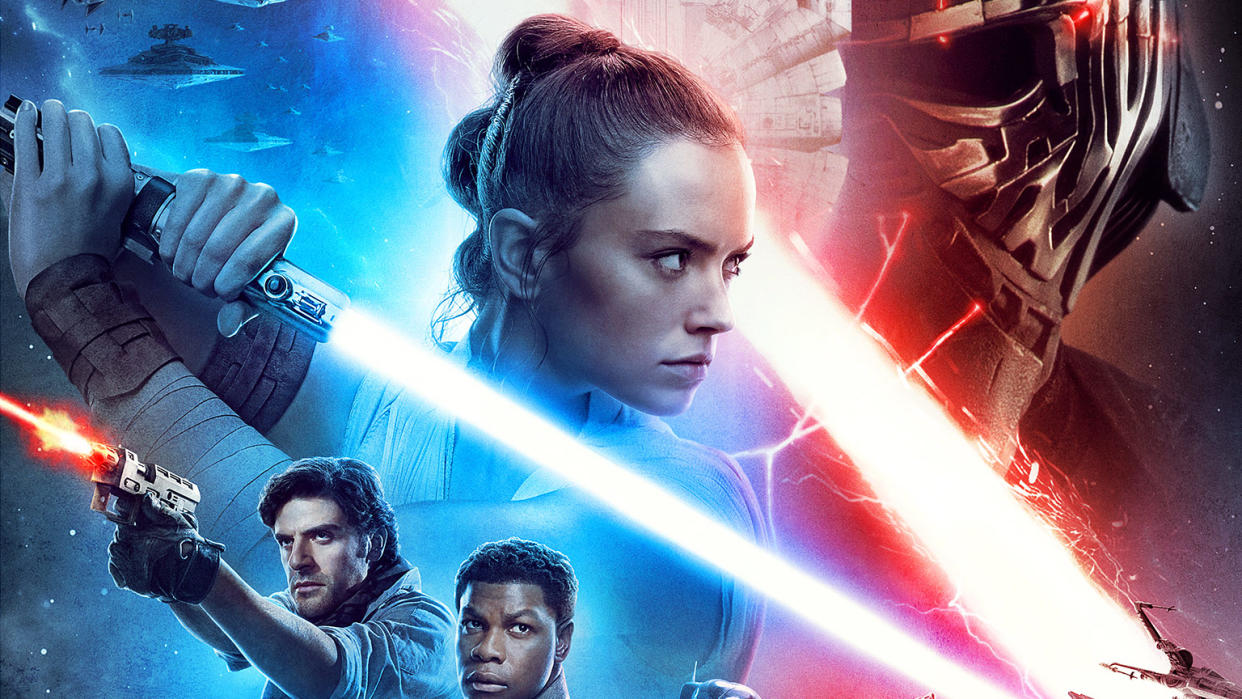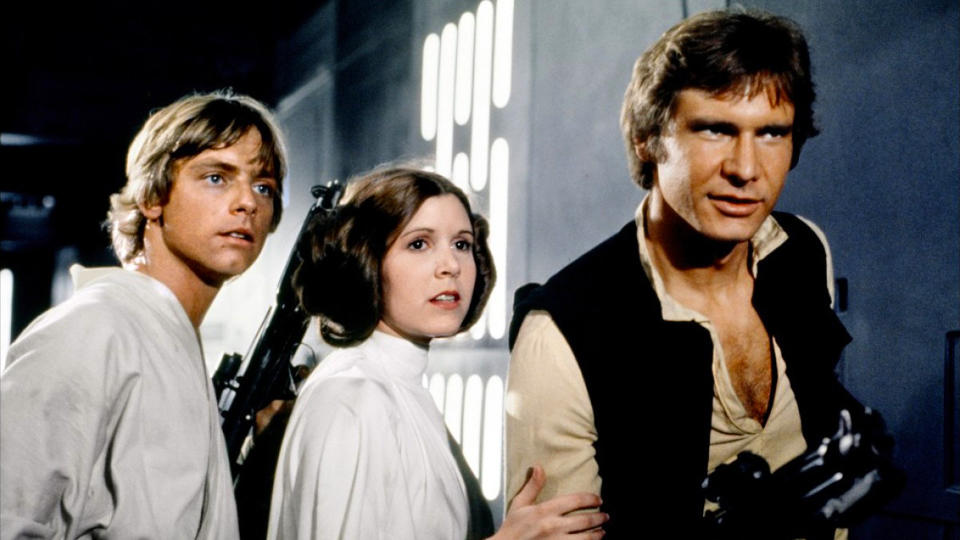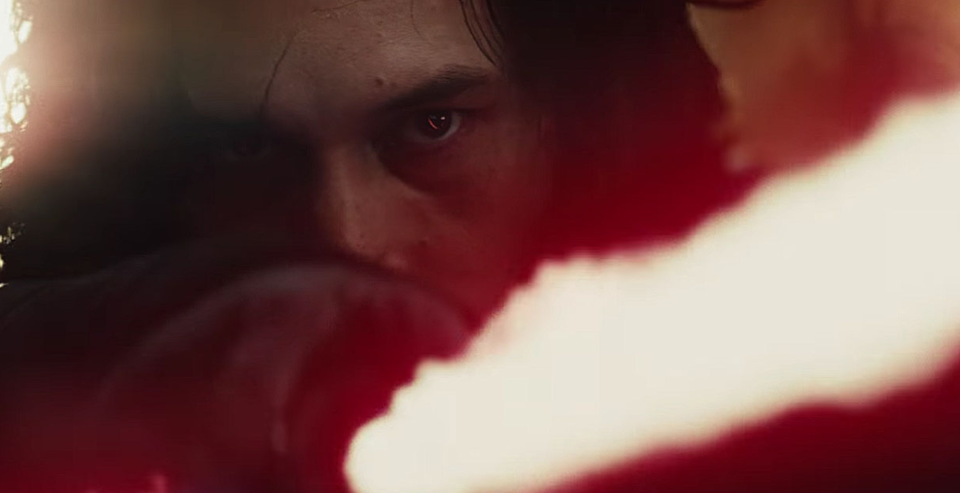The best order to watch ‘Star Wars’

Yahoo Entertainment is committed to finding you the best products at the best prices. We may receive a share from purchases made via links on this page. Pricing and availability are subject to change.
The home release of Star Wars: Rise Of Skywalker is approaching at lightspeed (it’s out digitally in HD and 4K Ultra HD™ on 13 April, and physically in 4K Ultra HD™, Blu-ray™, 3D Blu-ray™ and DVD on 20 April) which means soon you’ll be able to enjoy the full Saga from the comfort of your own home, as all the other live action films will be available to stream on Disney+ too.
Deciding to binge-watch nine movies (or eleven including the spin-offs) is actually the easy part, the real Jedi-level challenge you’ll face when they and on Disney+ is HOW to watch them. There’s a lot of different theories out there in terms of what the best order is.
But don’t worry, we have several viewing options - including one that’s sure to prove just a little bit controversial.
Read more: All the Star Wars coming to Disney+
So, put Baby Yoda to bed, take off your jet-pack, put down your lightsaber, and get ready for the ultimate guide to your next Star Wars viewing party.
Theatrical Release Order

A New Hope/Empire Strikes Back/Return of the Jedi
Phantom Menace/Attack of the Clones/Revenge of the Sith
The Force Awakens/The Last Jedi/Rise of Skywalker
Then: Rogue One and Solo
Kind of obvious, but start with the best three films, get through the prequels, then watch all of George Lucas’ hard work slowly becoming undone in the final trilogy...
...We’re joking, of course - the new trilogy’s fast-pacing actually works perfectly for this kind of binge-watch. This way you can start on a high with the first three films, chill as things slow down / get weird with the prequels, then end on an adrenaline rush of the fan-pleasing new stuff. And as long as you don’t overthink the overall narrative (such as the fact Palpatine turns out to be the actual MVP of the series), you’ll probably enjoy this method the most.
Breaking Bad’s Aaron Paul certainly agrees. “You start with the original Star Wars movie. There is no other way. Maybe it’s nostalgia. Or maybe it’s not even that. I have no idea why I feel this way, but you should watch them in the order they were released.”
Save the spin-offs for after, in case you suffer withdrawal symptons.
Saga Order

Phantom Menace/Attack of the Clones/Revenge of the Sith
(Solo/Rogue One)
A New Hope/Empire Strikes Back/Return of the Jedi
The Force Awakens/The Last Jedi/Rise of Skywalker
Start with one, end with nine. This viewing order gets the prequels out of the way early, and allows you to enjoy a series that gets increasingly more exciting as it progresses.
Weirdly, this is also the best way to watch if you’re a fan of special effects. With the prequel CGI looking more dated than the original trilogy’s practical effects work, and with the new trilogy seamlessly combining state-of-the-art computer stuff with real aliens and production design, these films will get better as they go along for SFX nerds (and we include ourselves amongst their number).
Basically, this is the cinematic equivalent of eating your greens before you get your dessert.
Read more: What’s on Disney+ at launch
As Samuel L Jackson puts it: “Well, everything needs to be watched in numerical order if you want to follow the mythology of what’s happening. Start episode one and go through it that way. I would. The mythology is stronger in one through three and definitely one through six than in the other ones. The story of the Anakin is what all this has been about for so long. His bloodline is the strong bloodline, so you kind of need to know what’s going on there.”
Oh, and George Lucas would prefer you watch it in this order. “Start with one. That’s the way to do it right: 1, 2, 3, 4, 5, 6. That’s the way they’re supposed to be done. Just because it took a long time to film it doesn’t mean you don’t do it in order.”
And, hey, if you want to really get technical, you can throw in Solo and Rogue One between the prequels and the original trilogy.
The All Of It Order

But what if you want to watch every single piece of Star Wars media? How do you even begin to approach that? Well, you set aside a fortnight or so, and do it chronologically.
Start with The Phantom Menace and Attack of the Clones. Then, The Clone Wars Seasons 1 - 6, before putting on The Clone Wars: Crystal Crisis on Utapau. After that interruption, it’s back to The Clone Wars season seven (which will launch on Disney+ with two episodes when it arrives here).
Go back to the movies for Revenge of the Sith and Solo. Then, watch the Rebels shorts, before bingeing the whole of Rebels (seasons 1 - 4).
You get a movie triple-bill next: Rogue One, A New Hope, and Empire Strikes Back.
You technically have to watch Lego Star Wars: The Freemaker Adventures seasons 1 - 2 next - but all the Lego stuff is so tonally different, you could choose to skip it.
You’ve got one more movie - Return of the Jedi - before you get to binge The Mandalorian season one (on Disney+, releasing weekly).
Read more: The future of Star Wars is on TV
After the awesomeness of The Mandalorian, another tonal shift: Resistance season one (making sure to watch all the Resistance shorts between episode 11 and 12, as that’s where they fit). Then it’s back to Lego Star Wars for The Resistance Rises.
You get two more movies - The Force Awakens and The Last Jedi - before Lego Star Wars: All-Stars. Then it’s Resistance season two, Forces of Destiny volumes 1-4, and a trip to Galaxy's Edge at Disneyland / Walt Disney World if you really, really want the full story.
Then you can take a deep breath and watch The Rise of Skywalker, safe in the knowledge you are a true Jedi. Seriously, you deserve Chewie’s medal if you get through all of the above.
The Machete Order

IV, V, II, III, VI, VII, VIII, IX
A New Hope/Empire Strikes Back
Attack of the Clones/Revenge of the Sith
Return of the Jedi
The Force Awakens/The Last Jedi/Rise of Skywalker
This is extreme, but if you’re a prequel-hater, necessary. The Machete Order basically ditches The Phantom Menace from your binge-behaviour, with the logic that it doesn’t actually contain any essential information for the story. And it really dials down your exposure to Jar Jar, which is massively in this order’s favour.
You watch Star Wars and Empire Strikes Back, before watching Attack Of The Clones and Revenge Of The Sith, basically treating them like one long flashback after Vader’s big ‘I’m your dad, dude’ reveal at the end of Empire. Then, you get back on chronological track with Return Of The Jedi, ending with the new trilogy.
If you’re showing the series to your children, this might be the way to go - it’s the best way to preserve two big twists: Vader’s reveal, but also the underrated ‘Yoda is a Jedi master’ twist in Empire.
And if you want to save time, this is the way to do it. But there is another…
The Last Jedi Last Order

Phantom Menace/Attack of the Clones/Revenge of the Sith
(Solo/Rogue One)
A New Hope/Empire Strikes Back/Return of the Jedi
The Force Awakens/The Last Jedi
Okay, so this might be a bit controversial considering how much people hate The Last Jedi, but bear with us.
If you watch the movies in theatrical order, ending with The Last Jedi (basically dropping The Rise Of Skywalker), it leaves the Saga feeling more open-ended and exciting.
This way Luke’s ‘see you around, kid’ feels like more of a threat, like he’s still going to force ghost stalk Kylo Ren (who gets to remain a powerful villain, and not just a tool of the Emperor).
Rey gets to stay a nobody (and not a bloody Palpatine), and - perhaps most importantly - Sheev doesn’t magically come back to life, undoing everything Luke (and Vader) achieved in the original trilogy.
Seriously, watched in the context of a binge, Rise Of Skywalker is so detrimental to the original trilogy (and even the prequels), it’s probably best to just leave it out.
The Original Trilogy Order

A New Hope/Empire Strikes Back/Return of the Jedi
But if you REALLY want to save time, just watch the original three films. They’re the purest, and best, expression of what Star Wars actually is. If you’ve still got access to your original VHS copies, without all the special edition nonsense (Exclusive: Greedo did NOT shoot first!), even better.
Watching all of these films back to back, it’s hard not to come to the conclusion that this was a story best told in three parts, with a beginning, middle and an end, with every other installment significantly gilding the space lily. Search your feelings, you know it to be true.
The Rise Of Skywalker is available on DVD and Blu-ray in the UK on 20 April.
Every other Star Wars film will be available to stream on Disney+ when it launches in the UK on 24 March.
Pre-Order Disney+
Disney+ subscription | £49.99 a year for a limited time only
Fans can currently subscribe to Disney+ for the introductory price of £49.99. This pre-launch offer for the annual subscription is only available until 23 March 2020, and is equivalent to £4.17 per month.
Full details and information on how to subscribe are available on Disneyplus.com. Standard pricing at launch is confirmed at £5.99 per month, or £59.99 for an annual subscription.

 Yahoo Movies
Yahoo Movies 


